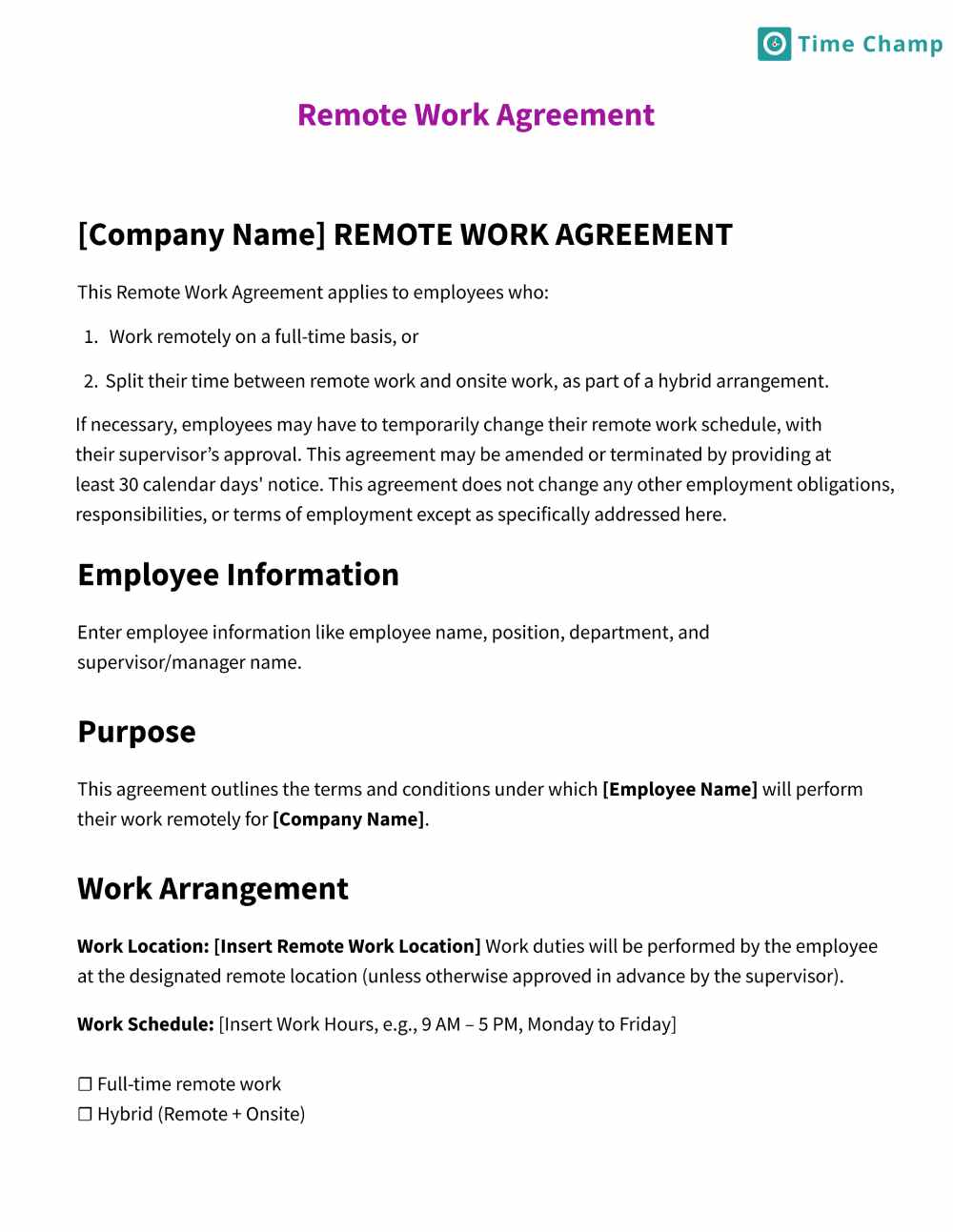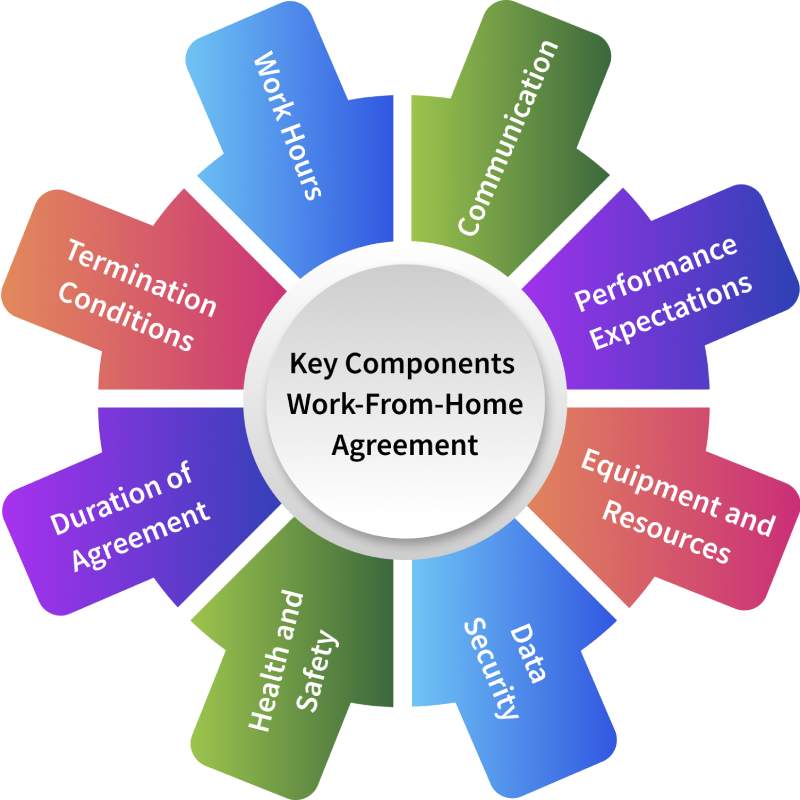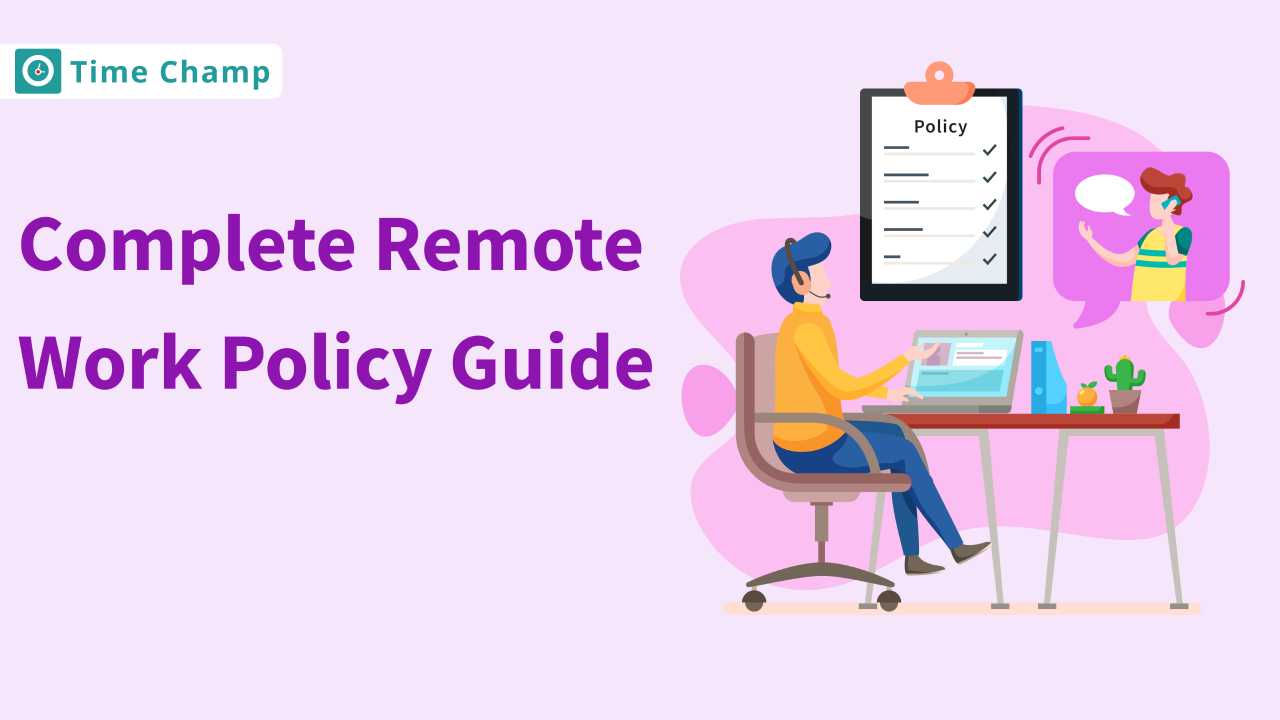According to a 2023 survey by Buffer, 27% of remote workers struggle with communication and collaboration. Managing the remote workers is challenging for the businesses. If you don’t have a clear remote work agreement, it can be confusing about who is responsible for what, and when they are expected to work. A lack of clarity can lead to less productivity, frustration, and even employee burnout many times.
Don’t worry! In this blog, we will explore what is a remote work agreement, along with a free well-defined template in Word & PDF formats and the key components you need to include. Let’s dive in!
What is a Remote Work Agreement?
A remote work agreement is a formal document that defines the terms and conditions of employees working from outside the traditional office. It defines the work hours, tasks that the employee is supposed to perform, the communication protocols, and the way the employee should use company equipment.
Why Do You Need a Remote Working Agreement?
Having a remote working agreement is essential as more businesses allow employees to work from home. According to a Global Remote Survey by Deloitte, over 80% of organizations have implemented remote work agreements. Here’s why it’s important to have this document in your organization.
1. Clarity of Expectations
Misunderstandings happen easily when your team members work away from the office. Having a remote working contract prevents confusion by stating clearly what is expected from each employee. This clarity leads to better performance and higher employee job satisfaction.
Employees are more effective when they know what their roles are. Also, the agreement should include performance goals. It also encourages feedback. Employees should be able to talk about the challenges they are facing.
2. Enhances Communication
A Salesforce study found that 86% of employees and executives cite a lack of collaboration or ineffective communication for workplace failures. In a work–from–home setting, communication is key. One of the best ways to improve communication is to have regular check-ins.
Your team members can easily and quickly interact with each other using communication platforms such as Slack, Microsoft Teams, or Zoom. Providing these platforms, your team can upload updates, files, and ideas in real-time. You should also outline how and when employees should communicate. For example, are team members expected to answer emails within two hours? Should they be on video calls during working hours? This reduces the confusion and maintains the workflow smoothly.
3. Supports Work-Life Balance
Employees who have a healthy balance between work and personal lives, tend to focus be engaged, and be loyal to the company. It helps your remote employees feel more satisfied and productive. This flexibility gives your employees the ability to juggle their work duties with their duties, such as taking care of their children and managing household tasks.
Allow your employees to take breaks and vacations to prevent burnout. According to a report by AssianEfficiency, employees who take regular breaks are 10% more productive than those who don’t take breaks.
4. Conflict Resolution
Conflict is a natural part of any workplace, including remote teams. Misunderstandings are more likely to happen when employees work from different locations. These conflicts can be reduced effectively by a remote working agreement.
A culture of respect and collaboration is essential to your remote team. Ask team members to share their concerns without fear. This method cannot only resolve conflicts but also build team members’ trust.
5. Encourages Accountability
Accountability is a key part of making your team thrive. A remote working contract encourages accountability. Accountability leads to better performance. It explains the role, makes employees perform better, and also increases engagement.
This agreement will help you have a more organized and responsible remote work environment. This will benefit not only your employees but also your entire organization.
Free Remote Work Agreement Template in (Word & PDF)Formats

Key Components You Need to Include in Work-From-Home Agreement
Here are the few key components you need to include in a remote work agreement:

1. Work Hours
When creating a work-from-home agreement, you need to specify work hours. The first step is to decide what standard work hours your team will work. Think about your business needs and your employees’ comfort. According to a survey by Flex Jobs, 73 percent of employees want flexible work hours. You also set break hours in the policy. You can let your employees take a 15-minute break for every 4 hours of work.
Owl Labs’ study found that companies with defined communication practices experience 34% less confusion about work expectations. Additionally, you can also add overtime and extra hours. If employees must work beyond normal working hours, you need to explain how they will be compensated. Flexibility, work breaks, availability, and overtime are good enough to form a fair and reasonable work-from-home policy.
2. Communication
Communication is key in a remote working agreement. Clear and regular interaction is important when employees work remotely, to keep the environment productive. According to Gartner, 98% of employees think that open lines of communication are essential to success. Then, select the proper tools for conversations. Employees should know which tools to use for which types of communication.
Set expectations for how quickly and how adequately they will respond. It lets projects move and not be delayed. If you include communication methods and expectations in the agreement, you will be able to build a strong remote work culture. Better productivity comes from happier employees.
3. Performance Expectations
If your employees know what is expected of them, they can do better. Outline job responsibilities. Give a clear view of daily tasks and long-term goals. These tasks should be described using simple language. For example, if an employee is in customer service, state how many calls they should take each day and how long they should take to respond to emails.
It’s also important to have regular check-ins. Set weekly or bi-weekly meetings to discuss performance. Then, your employees get a chance to ask questions and get feedback. When there are clear performance expectations, the outcomes are better.
4. Equipment and Resources
When you are creating remote work agreements, you need to make sure you outline the equipment and resources you provide to your employees to do their jobs. First, find out what tools they need for remote work. A reliable computer, high-speed internet, and software to connect with colleagues is what most remote employees need. Global Workplace Analytics reports that 77% of remote workers feel more productive when they have the right tools.
Also, think of software and subscriptions. There are many applications for communication, project management, and data storage. Time Champ is a popular tool for managing projects and productivity tracking, Zoom for meetings, and Slack for messaging. Don’t forget about support. Your employees may have technical issues at home. This can be overcome quickly if you designate a support contact. If your employees are buying equipment or software on their own, they need to know how they can get reimbursed.
5. Data Security
Protecting sensitive information is important when employees work from home. You should include clear guidelines about confidentiality and data security in agreements. Then, it’s easier for your employees to know what they need to protect. Describe the exact things that employees must do to ensure that this information is safe. For instance, employees should use strong passwords and turn on two-factor authentication on their devices.
Virtually all of this risk can be reduced simply by encouraging strong password practices. Advise your employees to keep office-related documents in a safe place. According to the Identity Theft Resource Center, almost 30 % of data breaches are caused by lost or stolen paper documents. Add clear consequences if do not follow these guidelines.
6. Health and Safety
The health and safety of your employees still matter when they work remotely. As an employer, you have to make sure that your employees work in a safe work environment at home just like in the office. It helps to protect your employees and your business. According to studies, 44% of remote workers feel uncomfortable because of a poor workspace setup.
Encourage your employees to change their workspace to help them sit up straight and be comfortable. You should also give support for their mental well-being. Safety during work hours is also an important aspect. Make sure they have appropriate tools and resources. For a job that requires special equipment, make it available. An employee who remains safe and well-equipped is more likely to perform better.
7. Duration of Agreement
You must define the duration of the agreement in your work-from-home policy. Include start and end dates, review periods, as well as any potential to extend. This clarity keeps good communication and a successful remote work environment.
Define the date that your company agrees to start the remote work arrangement. It allows employees to know when they will start their work-from-home schedule. If there is an end date, include that too. Many companies set a temporary period, such as six months, and then review the situation.
8. Termination Conditions
Any remote working agreement has termination conditions. These conditions describe how the relationship of employment terminates. You should be clear about the reasons for termination. Poor performance, violation of company policies, and misconduct might be the reasons. You should also specify how much notice is needed for termination.
Additionally, include conditions for immediate termination. The Equal Employment Opportunity Commission reports that over 90% of workplace harassment cases are unreported. Make sure you cover how sensitive information is handled after termination. While working from home, employees may have access to company data. They need to know how they should return or destroy this information.
Conclusion
A good remote work agreement is important for both employers and employees. It clarifies expectations and helps avoid misunderstandings. By using our customizable template in Word or PDF formats, you can make sure that all important details are covered. Take the time to create a strong agreement; it will benefit your remote work experience. Start enhancing your remote work setup today.
Frequently Asked Questions
Remote Work Agreements set out clear expectations between the employer and employee about when should work be done, how to communicate, what is expected performance, how equipment should be used, and other elements such as confidentiality. This agreement helps both employers and employees to make a remote work environment effective.
Yes, a Remote Agreement can be adjusted as per the employees’ role, and work requirements and based on their needs. For instance, full-time remote workers may have different terms than those who work in a hybrid arrangement.
Regular check-ins, performance appraisals, and performance tracking of project milestones are the common ways of monitoring remote workers’ performance. The agreement should specify the method of performance evaluation (monthly, or quarterly).
Responsibility for costs depends on the agreement between the employer and the employee. Normally work equipment like laptops, software, and security tools are supplied by employers. In some cases, companies may offer stipends or reimbursement for specific remote work expenses.
Yes, a remote work contract can be terminated or modified for the needs of the business or the employee. This means the employer can change the terms of the contract if the company’s demands for operation change with advance notice. Similarly, with their supervisor’s approval, employees may ask for modifications including changes in work hours, or location.







